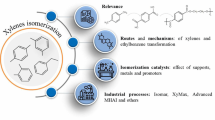Summary
-
1.
A study was made of the conditions required for the isomerization of m-xylene in presence of gumbrin and of a synthetic aluminum silicate catalyst at different temperatures and pressures.
-
2.
In presence of gumbrin the isomerization of m-xylene proceeds most smoothly at 450‡ under atmospheric pressure and at a space velocity of 0.5 hour−1. Under these conditions the yield of p-xylene attains 91.2% of the equilibrium amount.
-
3.
The use of reduced pressure (50 mm) favors the complete elimination of undesirable methylation and demethylation reactions and makes it possible to obtain almost 100% of liquid catalyzate containing 15.6% of p-xylene. The use of hydrogen under pressure (15 atm) results in the complication of the isomerization reaction by side reactions.
-
4.
The synthetic aluminum silicate was a less effective catalyst than gumbrin in that it favored side reactions and gas formation to a greater extent.
-
5.
In presence of Pt-Al2O3 at 500‡, m-xylene was again isomerized into the o- and p-isomers, but simultaneous formation of toluene (up to 5.5%) and trimethylbenzenes (up to 2.5%) occurred.
Similar content being viewed by others
Literature cited
E. R. Boedeker and W. E. Erner, J. Amer. Chem. Soc. 76, 3591 (1954).
A. D. Sulimov, V. I. Karzhev, T. V. Zhokhovskaia, V. M. Olevskii, E. G. Vebdel'shtein, E. I. Sil'chenko, N. V. Shavolian, and A. A. Voitekhov, Chemistry and Technology of Fuel, No. 1, 33 (1956).
Iu. G. Mamedaliev, A. V. Topchiev and G. M. Mamedaliev, Proc. Acad. Sci. USSR, 106, 1027 (1956).
P. M. Pitts, J. E. Connor and L. W. Leum, Industr. and Engng. Chem. 47, 770 (1955).
U. S. Patent 2632779 3/24/1953;Chem Abstrs. 48, 2096 (1954); U. S. Patent 2656397, 10/20/1953; Referat. Zh. Khim. No. 23, 258 (1954); U. S. Patent 2695323, 11/23/1954; Referat. Zh. Khim. No 23. 396 (1955); British Patent 695947, 8/19/1953; Chem. Abstrs. 48,8821 (1954); French Patent 1082941, 6/22/1953; Chem. Zentr-alblatt 42, 11598 (1956).
H. W. Haines, J. M. Powers and R. B. Bennet, Industr. and Engng. Chem. 47, 1096 (1955).
J. Mlodecka, Przem. Chem. 11, 315 (1955); Referat. Zh. Khim. No.7, 264 (1956).
W. J. Taylor, D. D. Wagman, M. G. Williams, K. S. Pitzer, and F. D. Rossini, J. Res. Nat. Bur. Standards 37, 95 (1946).
Author information
Authors and Affiliations
Rights and permissions
About this article
Cite this article
Shuikin, N.I., Tulupova, E.D. & Poliakova, Z.P. Catalytic transformations of m-xylene in presence of aluminum silicates. Russ Chem Bull 7, 1422–1426 (1958). https://doi.org/10.1007/BF00914856
Received:
Issue Date:
DOI: https://doi.org/10.1007/BF00914856



